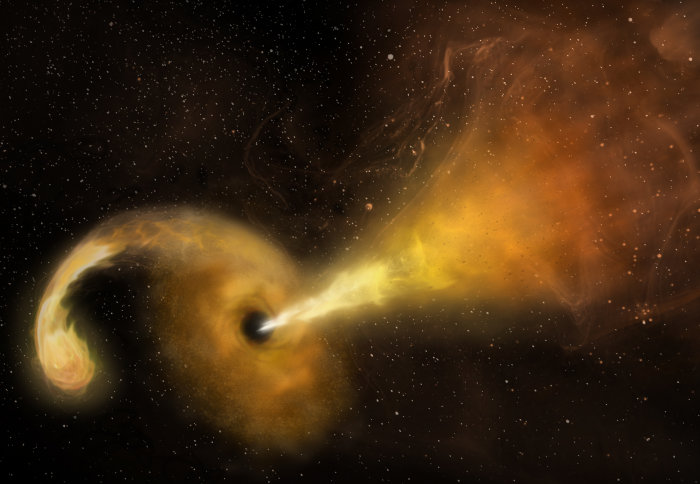Scientists spot erupting jets of material as black hole tears a star apart

Astronomers have for the first time directly imaged a fast-moving jet of material ejected as a supermassive black hole consumed a star.
Scientists have previously detected a few cases of black holes destroying stars, but this is the first time they have imaged a bright jet of material from the event.
The way the jets were detected means researchers are hopeful they can spot more similar events. Such events may have been more common in the early universe, so studying them may help scientists understand the environment in which galaxies developed billions of years ago.
This project has been quite an epic, with observations and analysis spanning 13 years. Dr Dave Clements
The results, led by the University of Turku in Finland and the Astrophysical Institute of Andalucia in Spain, and including Imperial College London researchers, are published online today in the journal Science.
Only a small number of this kind of stellar deaths, called tidal disruption events (TDEs), have been detected. Physicists thought that material pulled from the doomed star would form a rotating disk around the black hole, emitting intense X-rays and visible light, and also launch jets of material outward from the poles of the disk at nearly the speed of light.
Now, these jets have been observed as a black hole, which is 20 million times more massive than our Sun, shredded a star more than twice the Sun's mass. Astronomers tracked the event with radio and infrared telescopes in a pair of colliding galaxies called Arp 299, nearly 150 million light-years from Earth.
Epic project
Dr Dave Clements, from the Department of Physics at Imperial, said: “This project has been quite an epic, with observations and analysis spanning 13 years. It all started when my colleague Professor Peter Meikle came into my office in 2005 and said ‘something odd is happening in Arp299’.”
The radio signals received by various telescopes and arrays over more than 10 years
Astronomers using the William Herschel Telescope in the Canary Islands had discovered a bright burst of infrared emission coming from one of the colliding galaxies in Arp 299. Follow-up observations with the National Science Foundation's Very Long Baseline Array (VLBA) revealed a new, distinct source of radio emission from the same location.
Infrared and radio waves are those emitted beyond the visible light spectrum. The astronomers had expected to see visible light and X-rays (below the visible spectrum) created by the TDE, but think they only observed infrared and radio waves because of the amount of dust in the galaxy.
Absorbed by dust
Dr Seppo Mattila, from the University of Turku, said: "As time passed, the new object stayed bright at infrared and radio wavelengths, but not in visible light and X-rays. The most likely explanation is that thick interstellar gas and dust near the galaxy's centre absorbed the X-rays and visible light, then re-radiated it as infrared."
Continued observations carried out over nearly a decade showed the source of radio emission expanding in one direction, just as expected for a jet. The measured expansion indicated that the material in the jet moved at an average of a quarter of the speed of light.
Dr Miguel Perez-Torres, from the Astrophysical Institute of Andalucia, said: “Much of the time supermassive black holes are not actively devouring anything, so they are in a quiet state. Tidal disruption events can provide us with a unique opportunity to advance our understanding of the formation and evolution of jets in the vicinities of these powerful objects.”
-
‘A dust-enshrouded tidal disruption event with a resolved radio jet in a galaxy merger’ by S. Mattila et al. is published online in Science.
-
Image credits
Top image: NRAO/AUI/NSF
Animation: Bill Saxton, NRAO/AUI/NSF
Article text (excluding photos or graphics) © Imperial College London.
Photos and graphics subject to third party copyright used with permission or © Imperial College London.
Reporter
Hayley Dunning
Communications Division